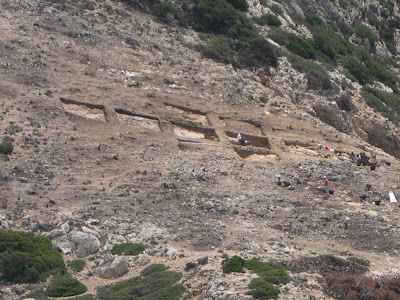 During this field season I poked around the numerous caves in the Kavos region, which may or may not be associated with the site.
During this field season I poked around the numerous caves in the Kavos region, which may or may not be associated with the site.
 With the aid of a couple of geologists TK and JED, and some archaeological buddies MM, KR and BM we managed to identify a bunch of cave-like features and perhaps event the Bassiakos and Doumas “ritual cave”.
With the aid of a couple of geologists TK and JED, and some archaeological buddies MM, KR and BM we managed to identify a bunch of cave-like features and perhaps event the Bassiakos and Doumas “ritual cave”. We excavated a small trench in order to look for evidence of human use in the cave . After about 60cm we hit bedrock (the natural limestone formation) and we recovered only one pottery sherd, one fragmented shell/goat animal bone (I was listening to SWK all of those years) and one sea shell. Perhaps they have austerity measures in Hades and the old adage that "you can't take it with you" in fact true.
We excavated a small trench in order to look for evidence of human use in the cave . After about 60cm we hit bedrock (the natural limestone formation) and we recovered only one pottery sherd, one fragmented shell/goat animal bone (I was listening to SWK all of those years) and one sea shell. Perhaps they have austerity measures in Hades and the old adage that "you can't take it with you" in fact true. 






















